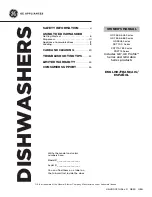
13
English
Proper Use of Detergent
• The amount of detergent to use depends on the type of water in your
area. Hard or soft water and if items are lightly or heavily soiled will
affect the amount of detergent to use.
• Water softness or hardness is measured in grains content per gallon
(gpg). You can find out the gpg level by calling your local Environmental
Protection Agency (EPA) in your county.
• If you find that the gpg level is higher in the water, then the water will be
harder in your living area. You will need more detergent to clean. If gpg
level is lower, then the water will be softer in your living area so you will
need less detergent to clean.
See the following table to understand the "water hardness type" and gpg
level.
Note
: If gpg level is over 12, then water is very hard. You may need water
softener to improve the water quality and the performance of
your dishwashing.
The quality of the detergent will make a big difference in the
cleaning of dishes. Detergent that is damp or too old will not give an
effective clean because the active ingredients are phased off.
Note:
Use only "
Automatic Dishwasher Detergent
" for your dishwasher.
Other types of detergents that are not for dishwasher use may cause
over suds and foaming. Do not use detergents that are dried, caked
or moist. These types of detergents will not dissolve properly
Water hardness type
gpg
hard
10+
medium
4-9
soft
0-3













































